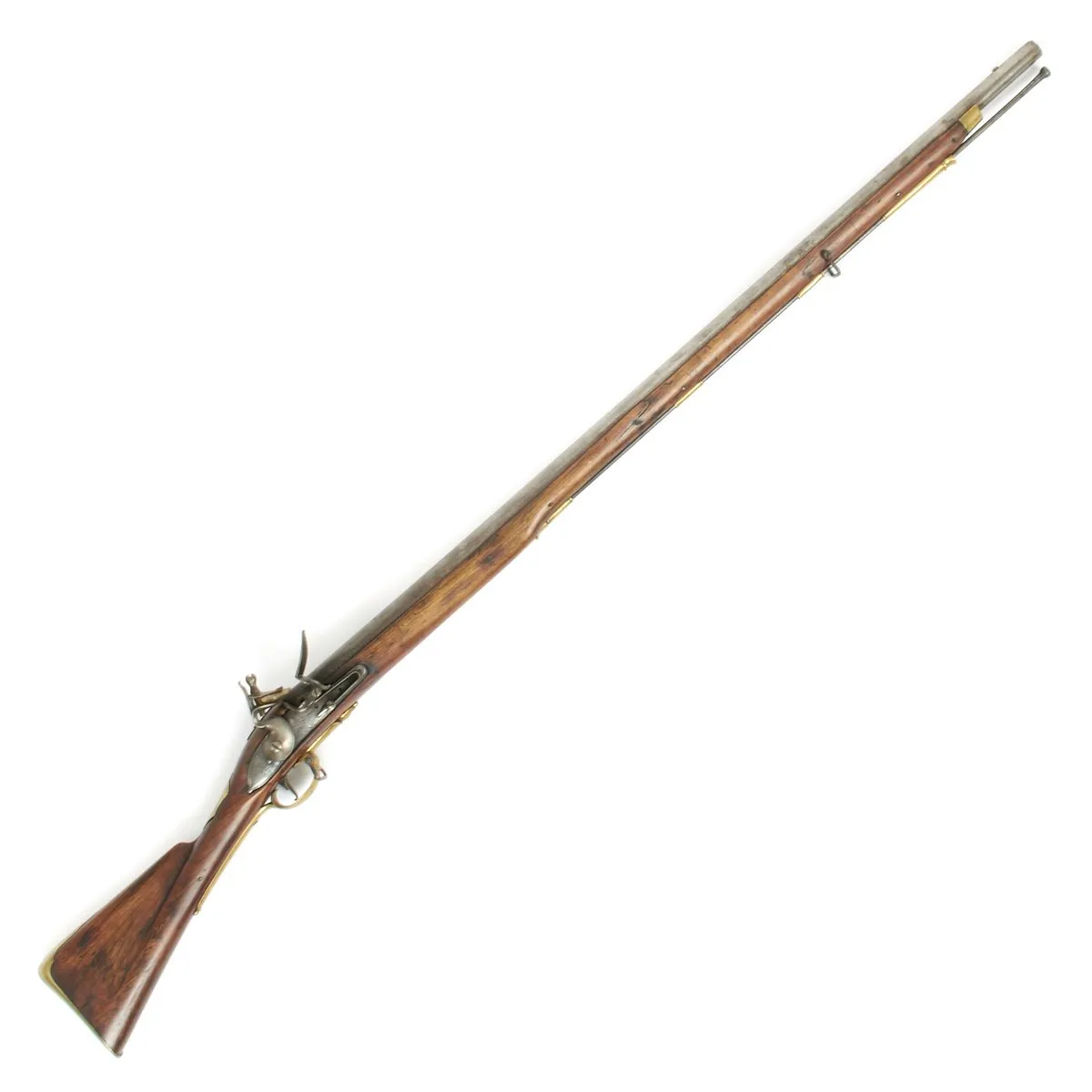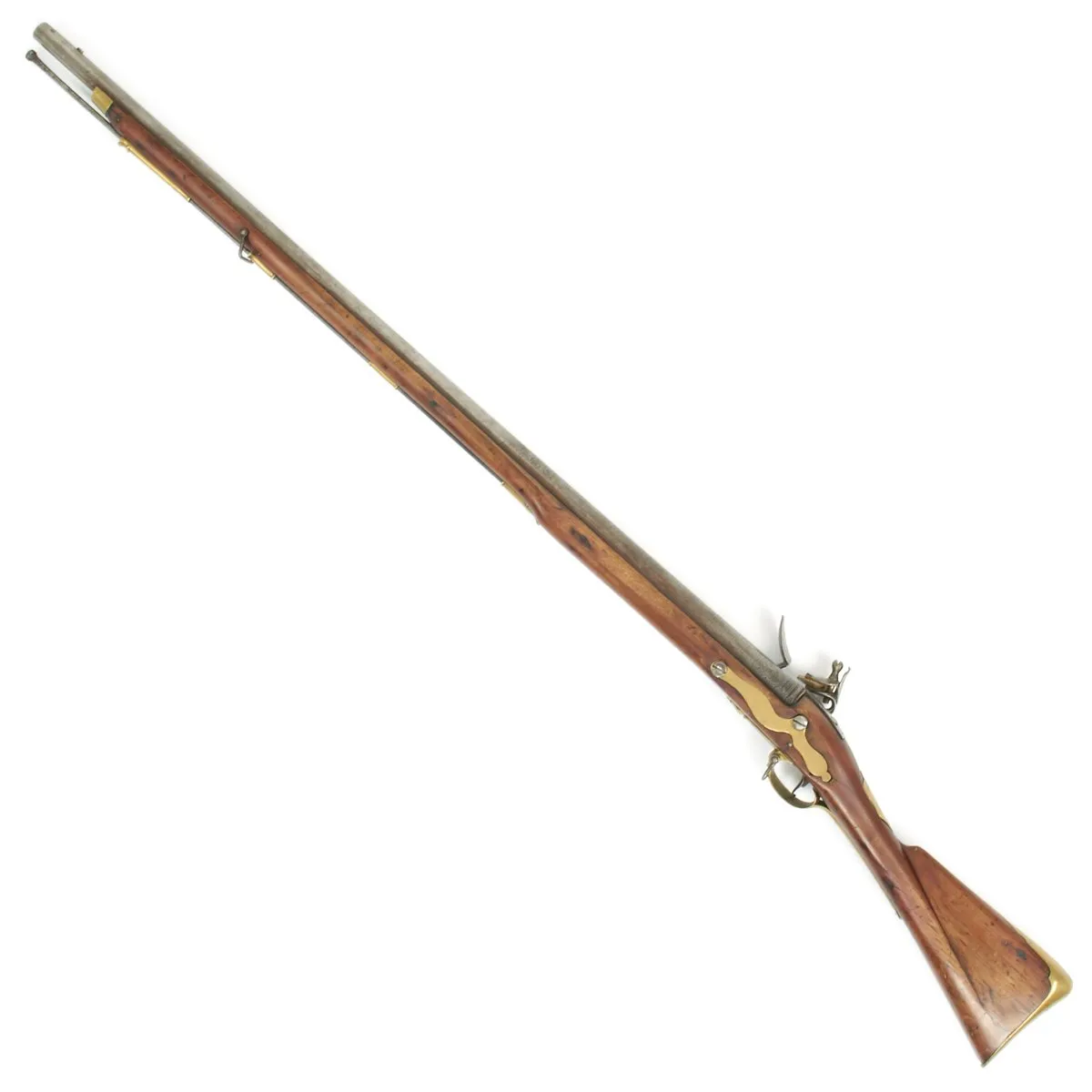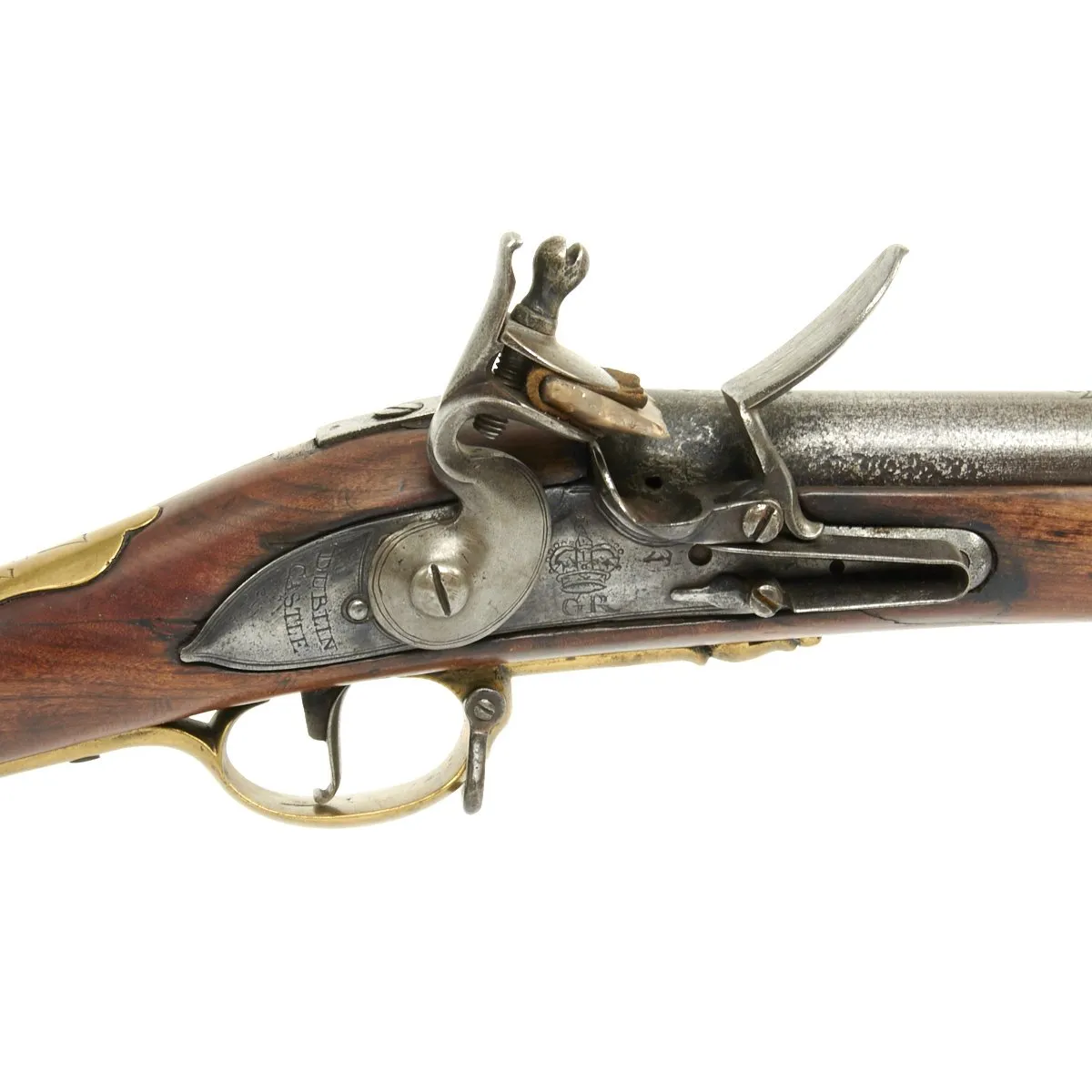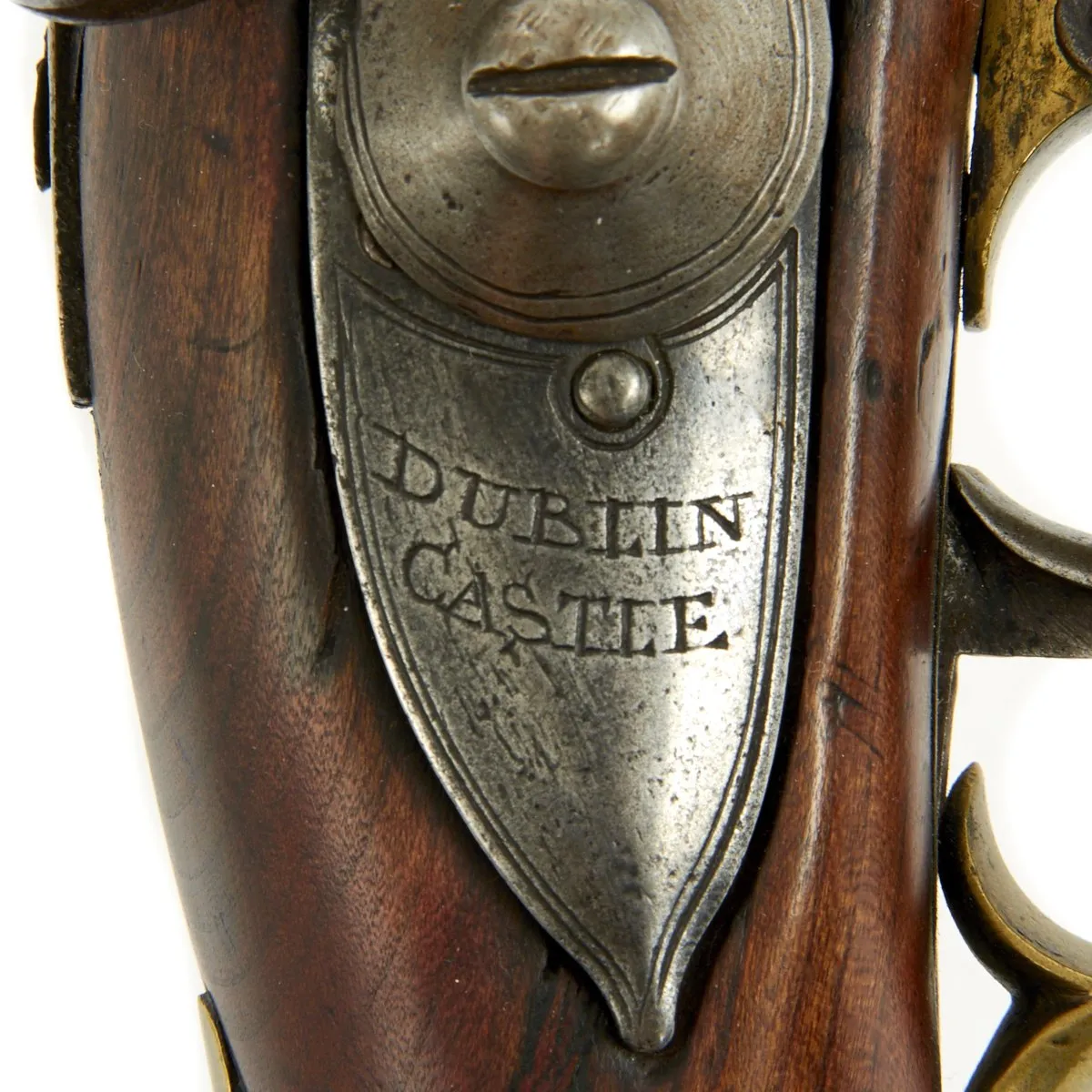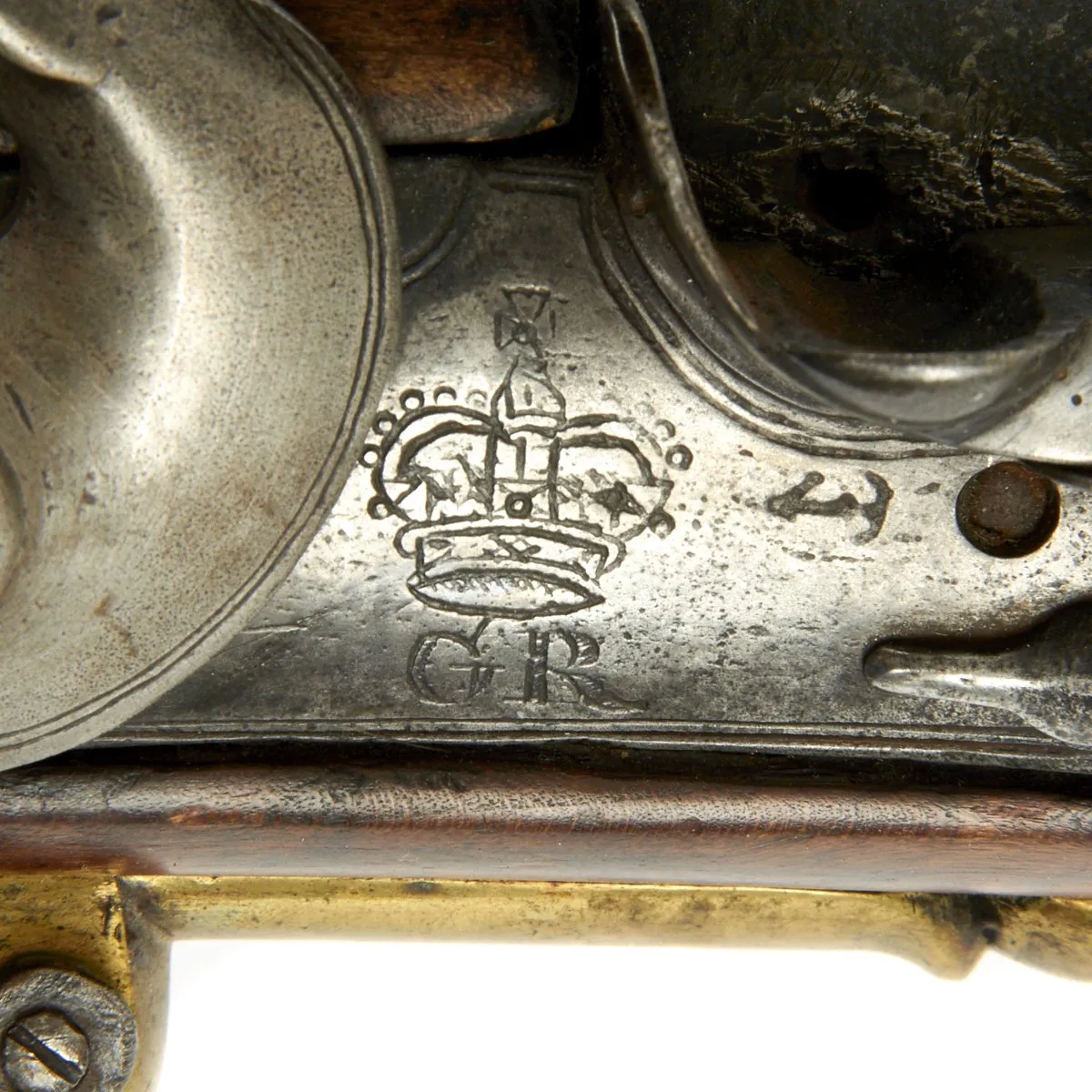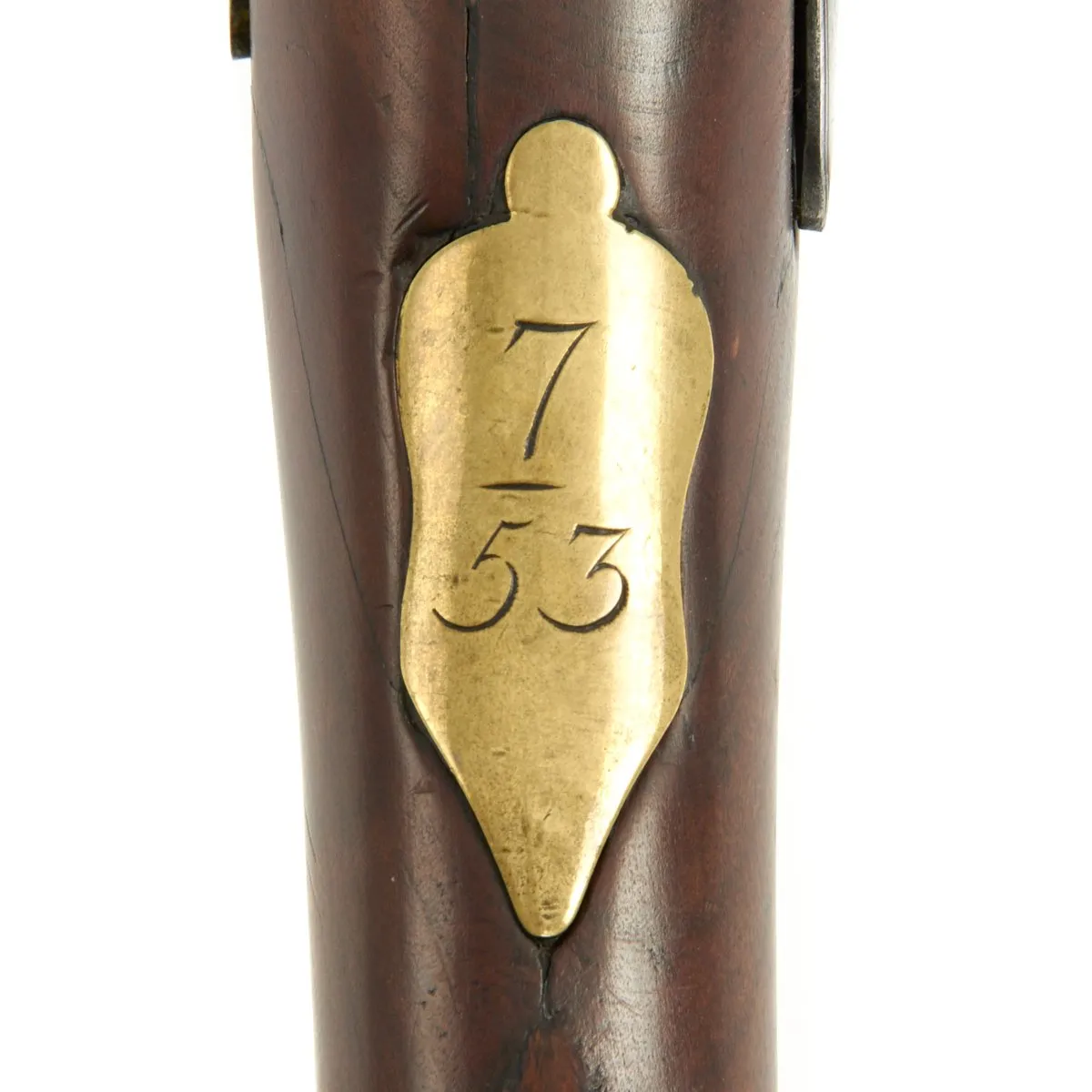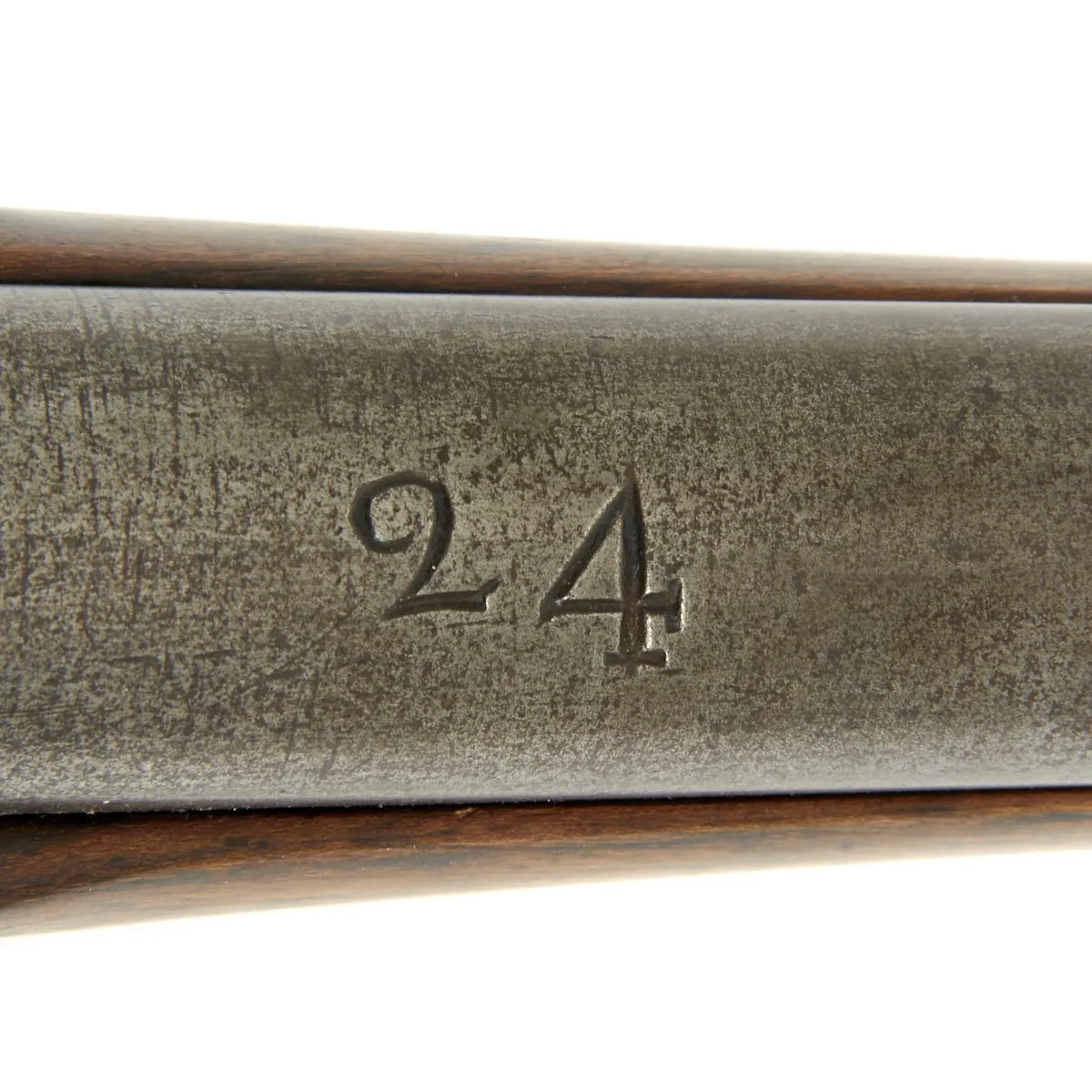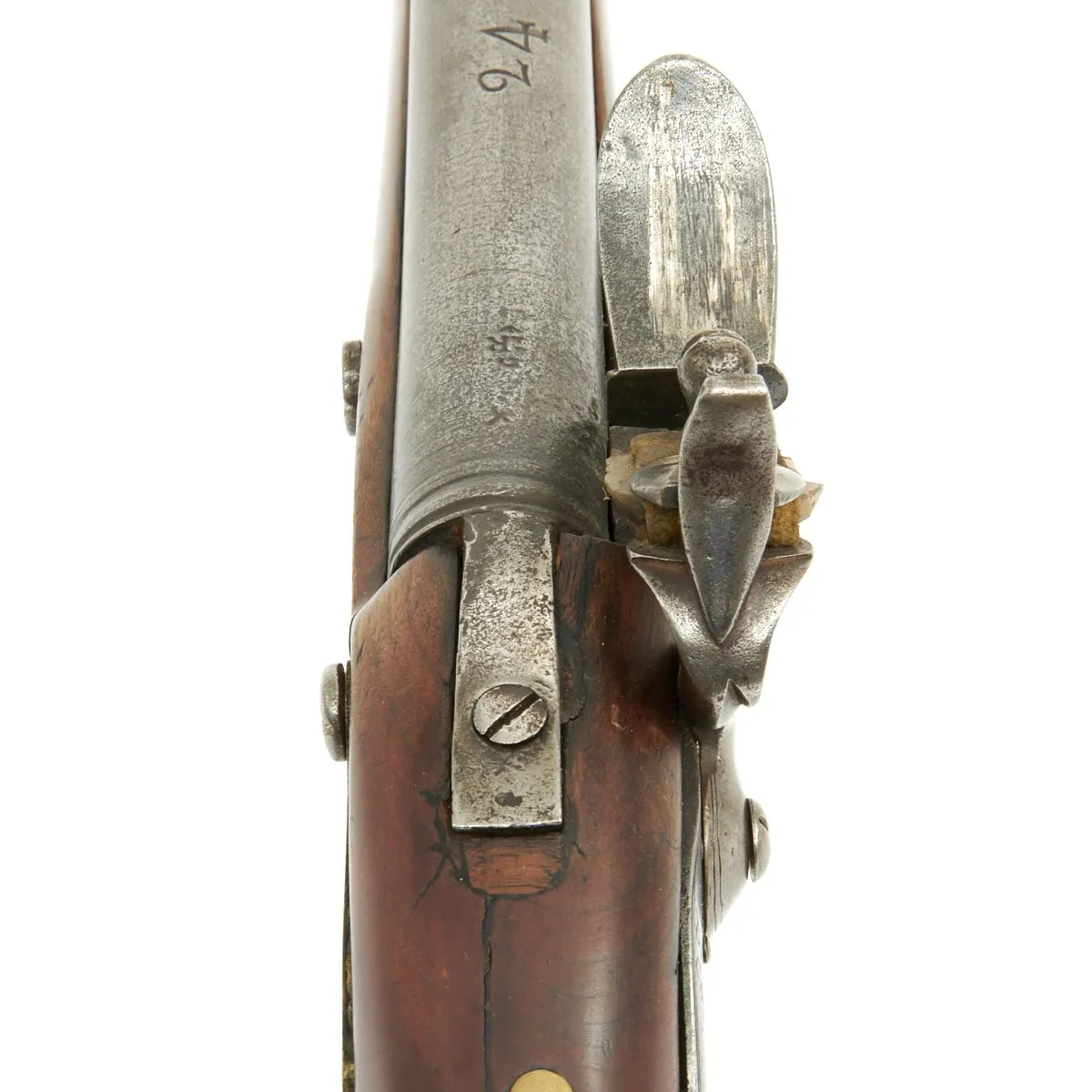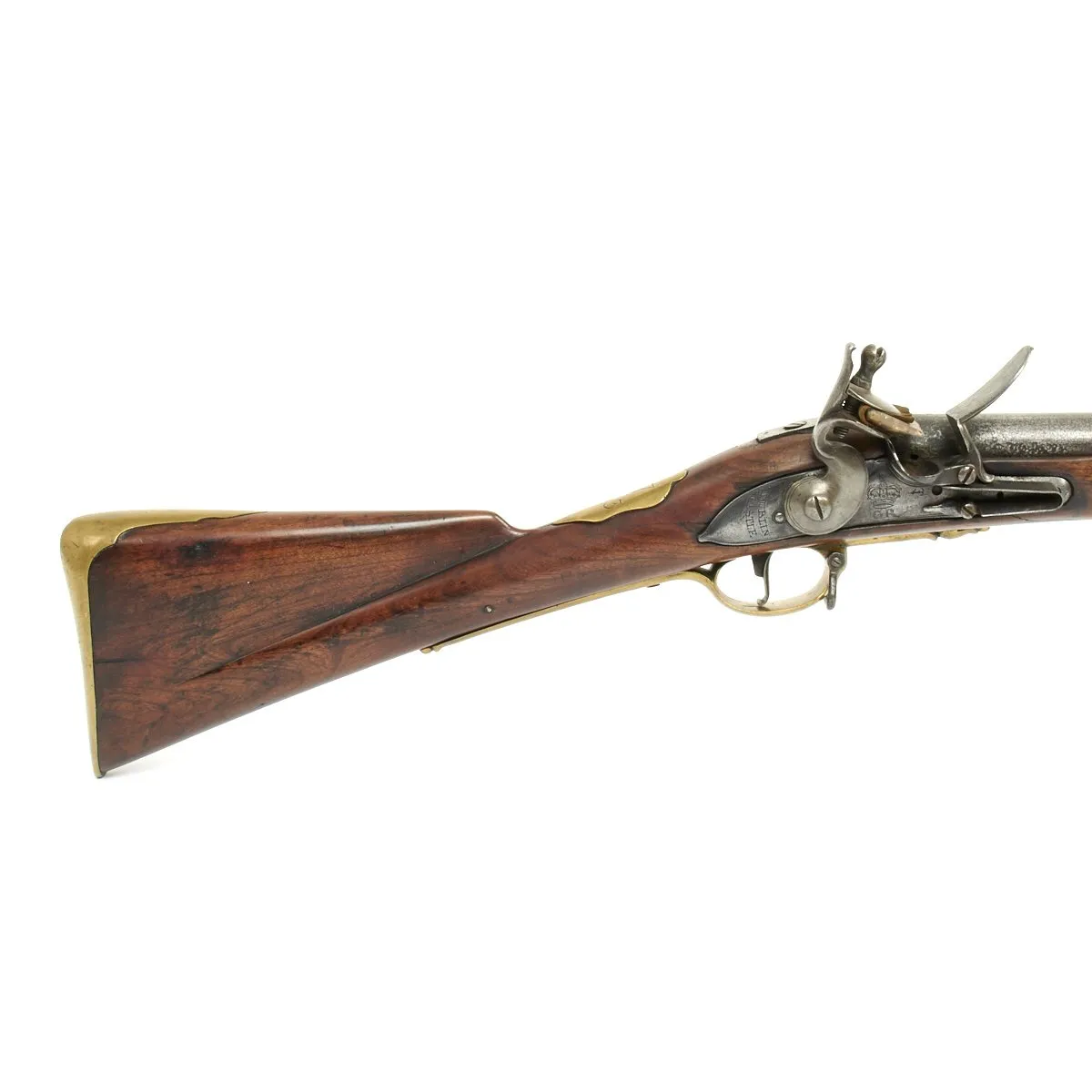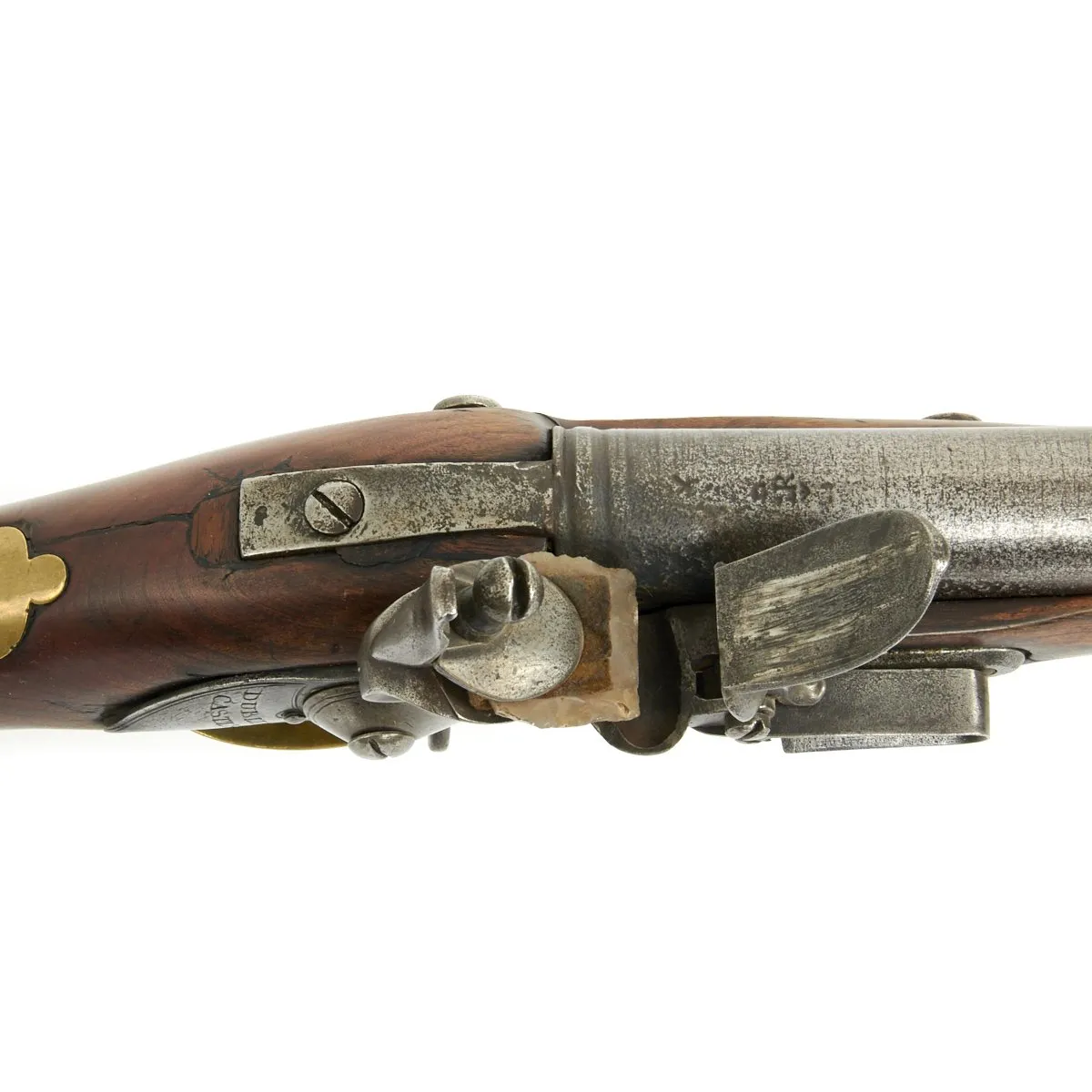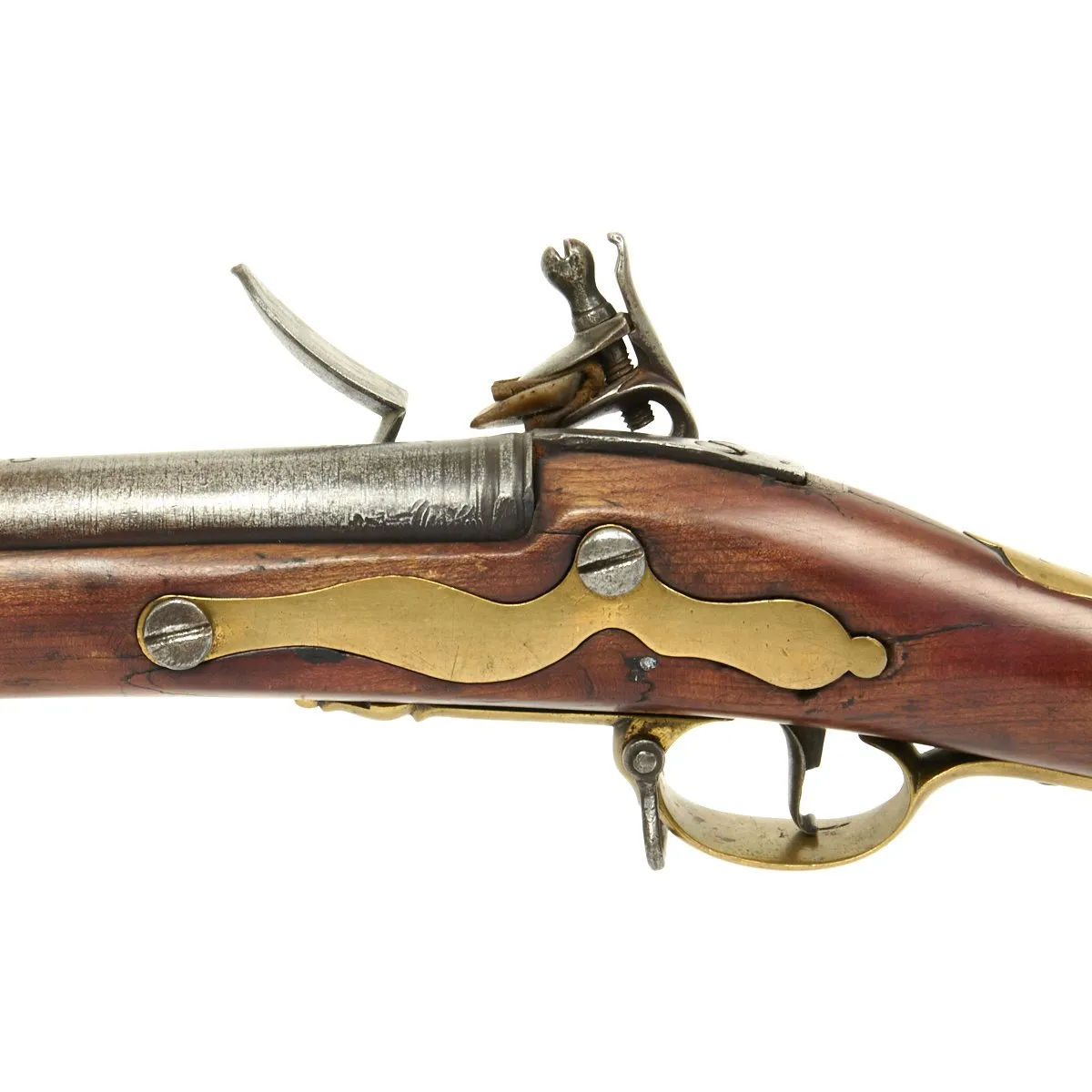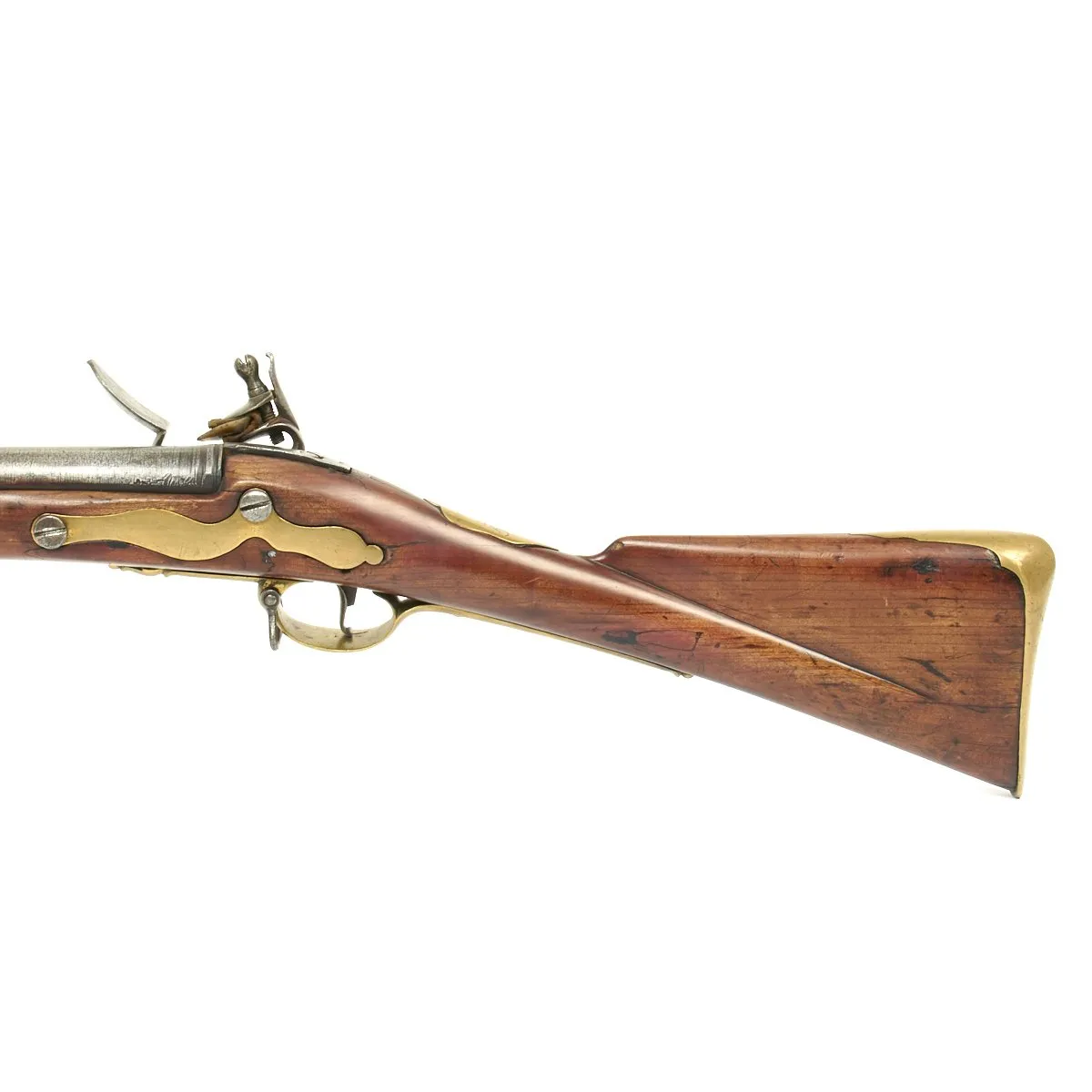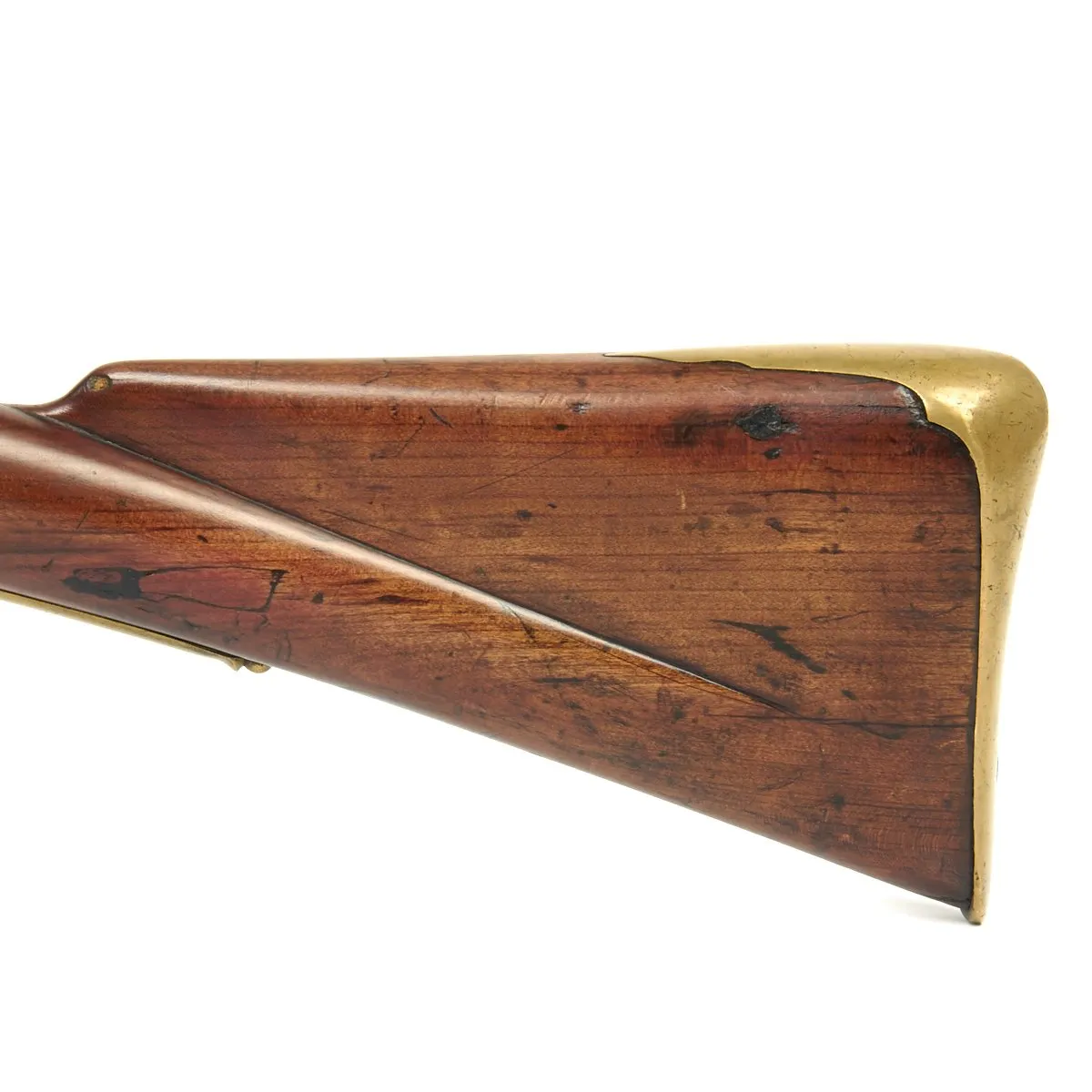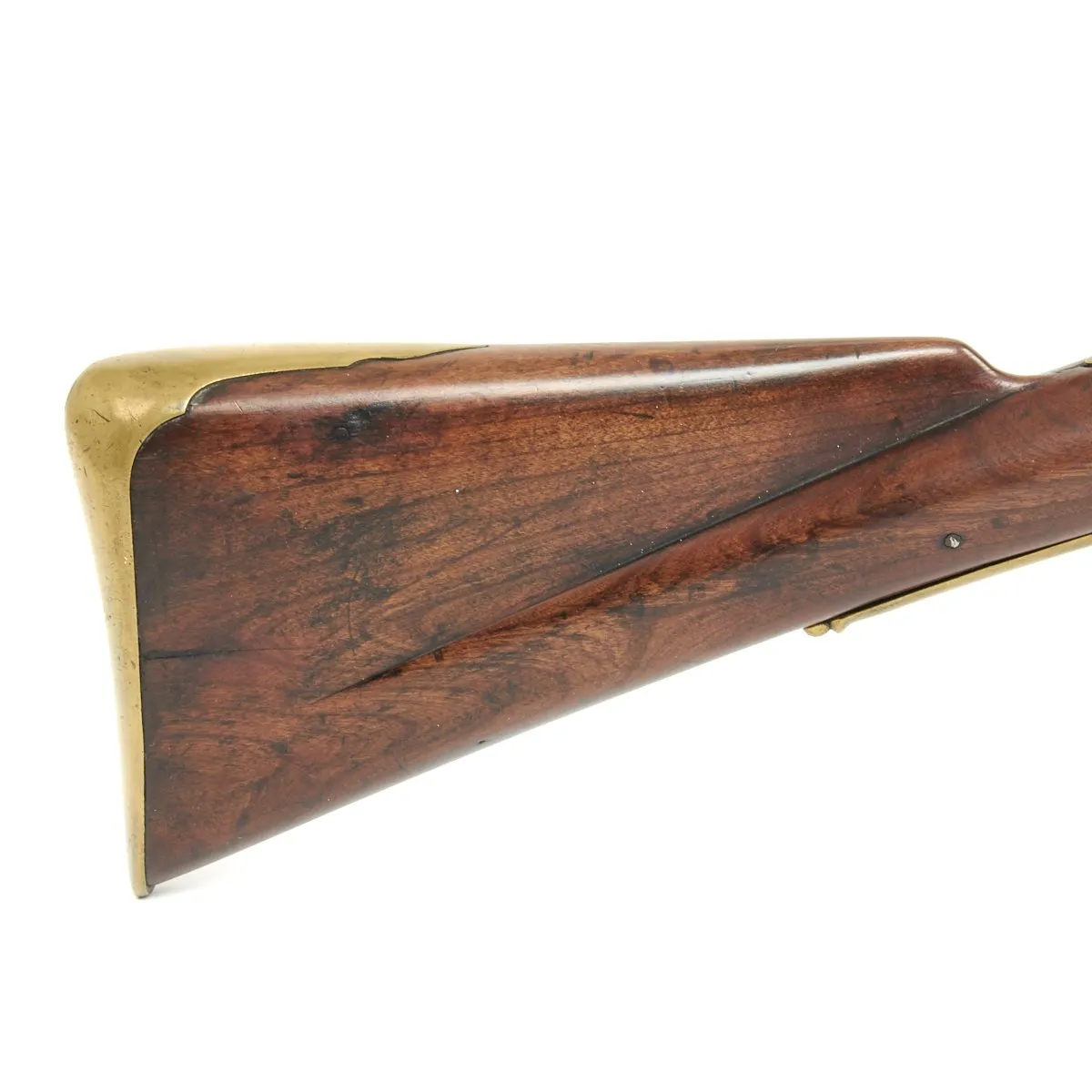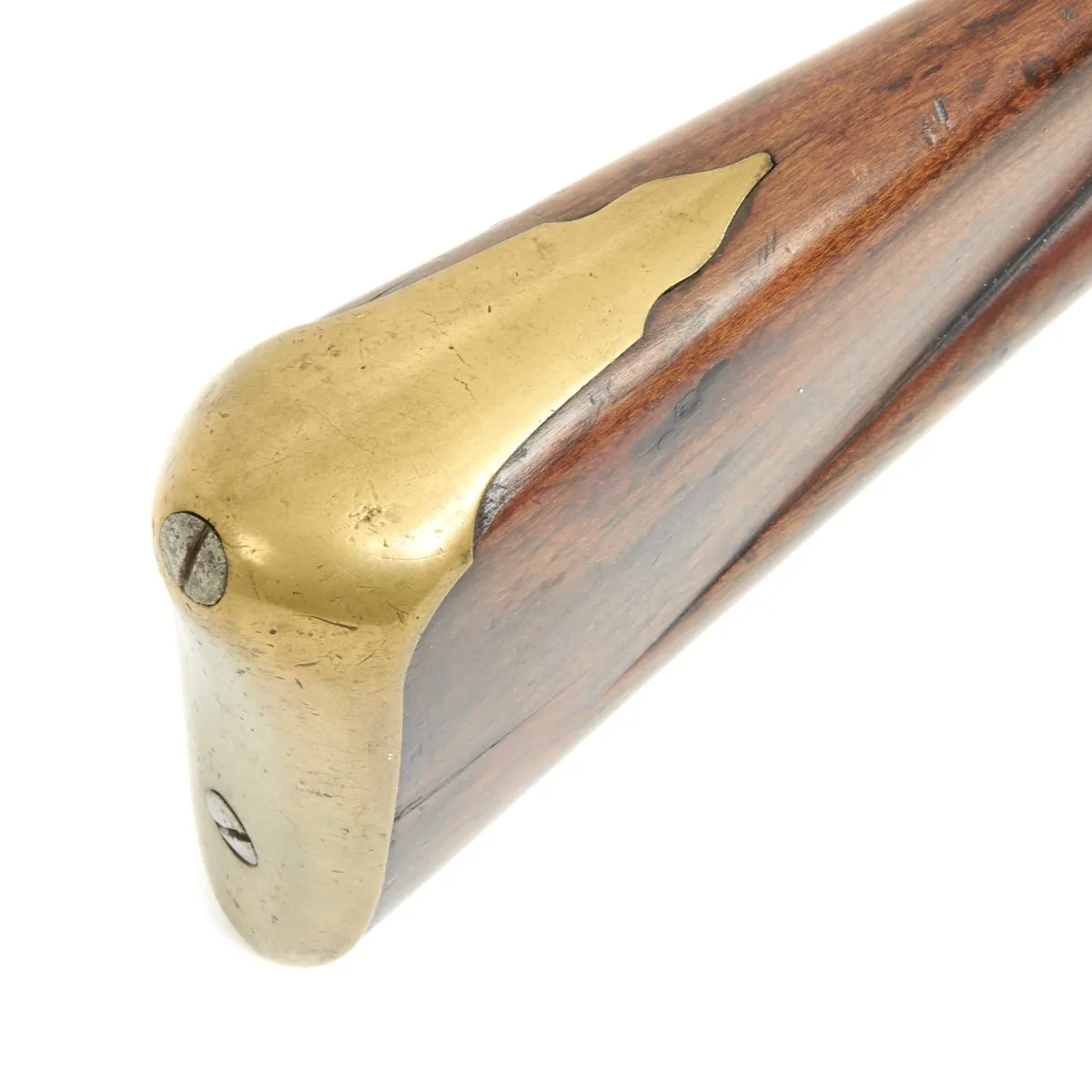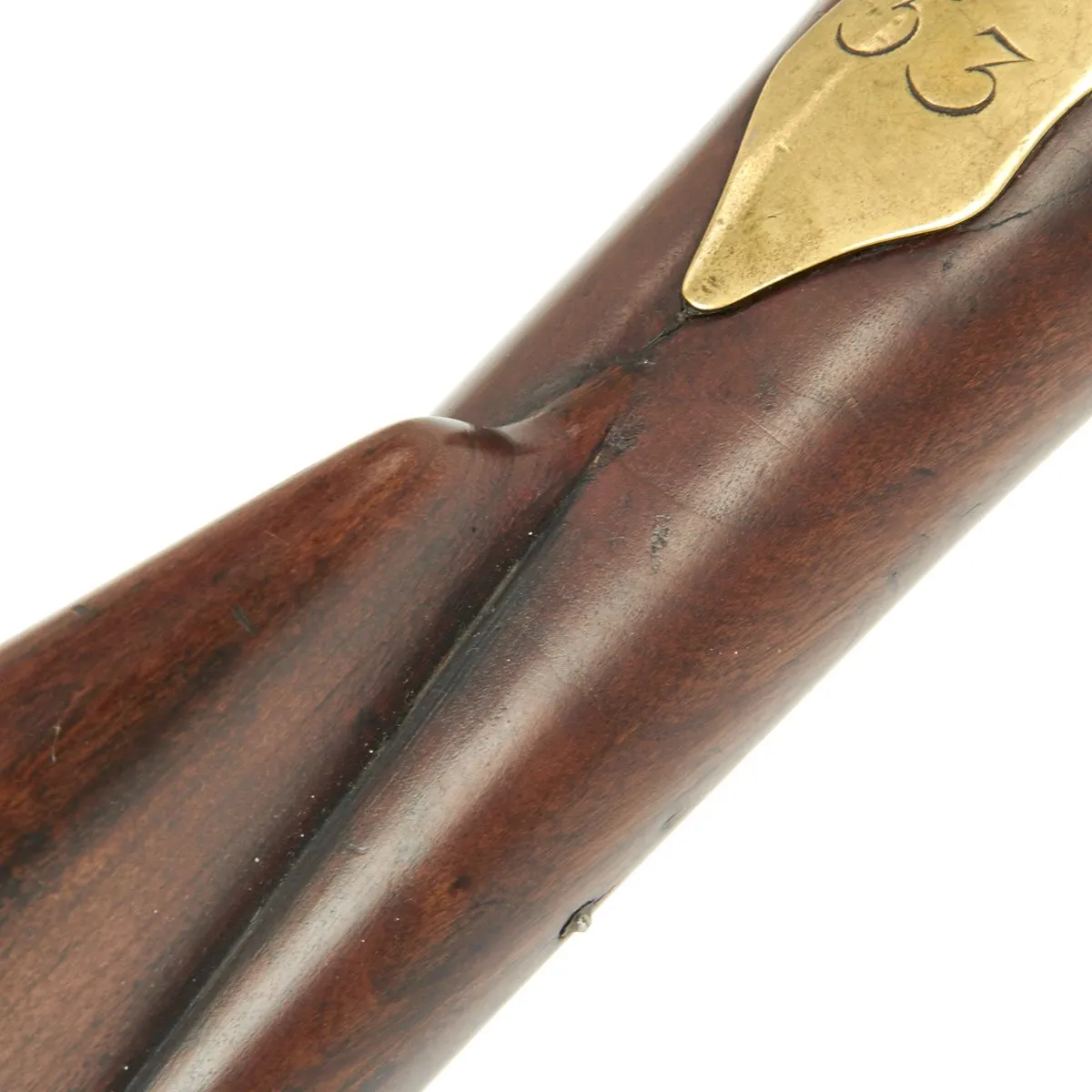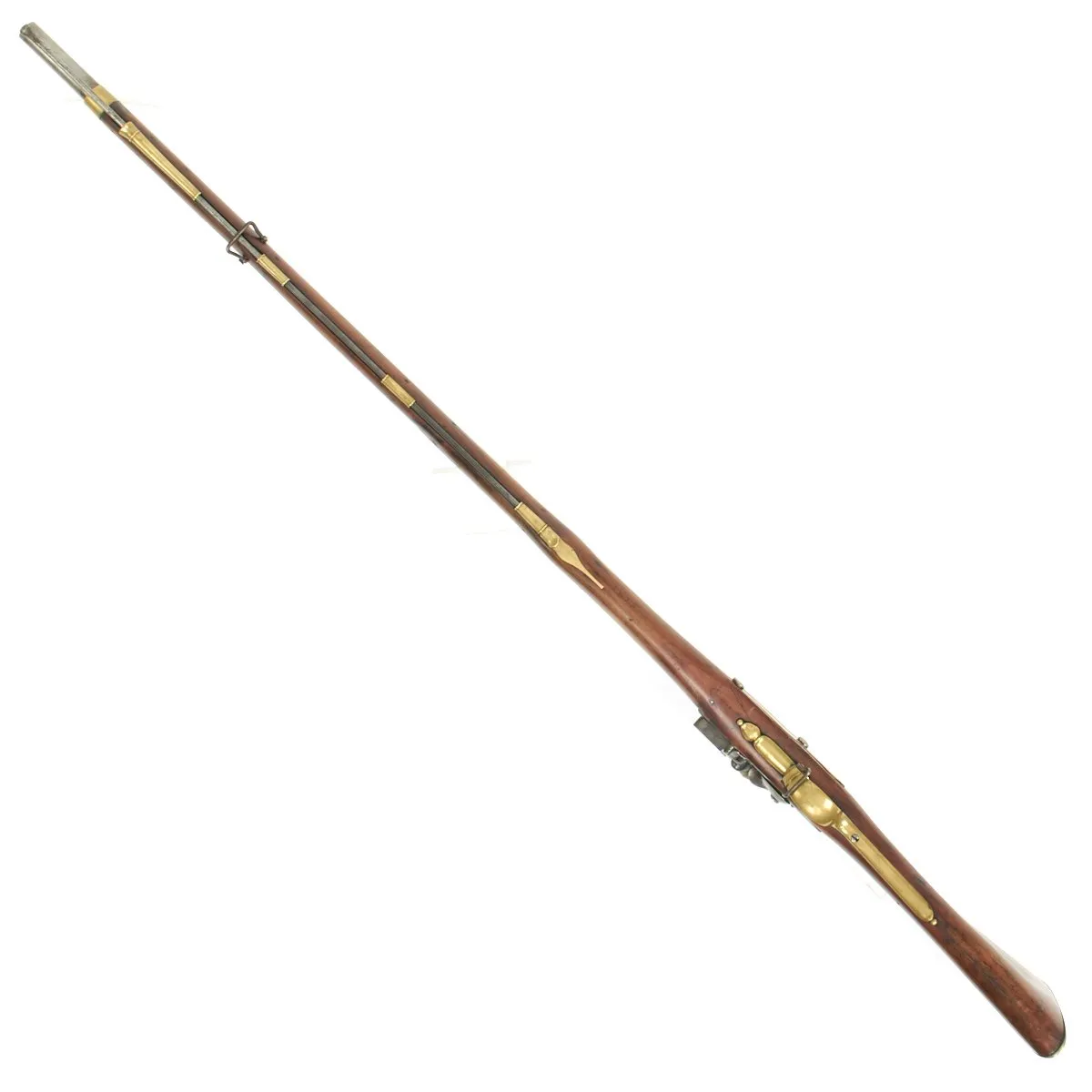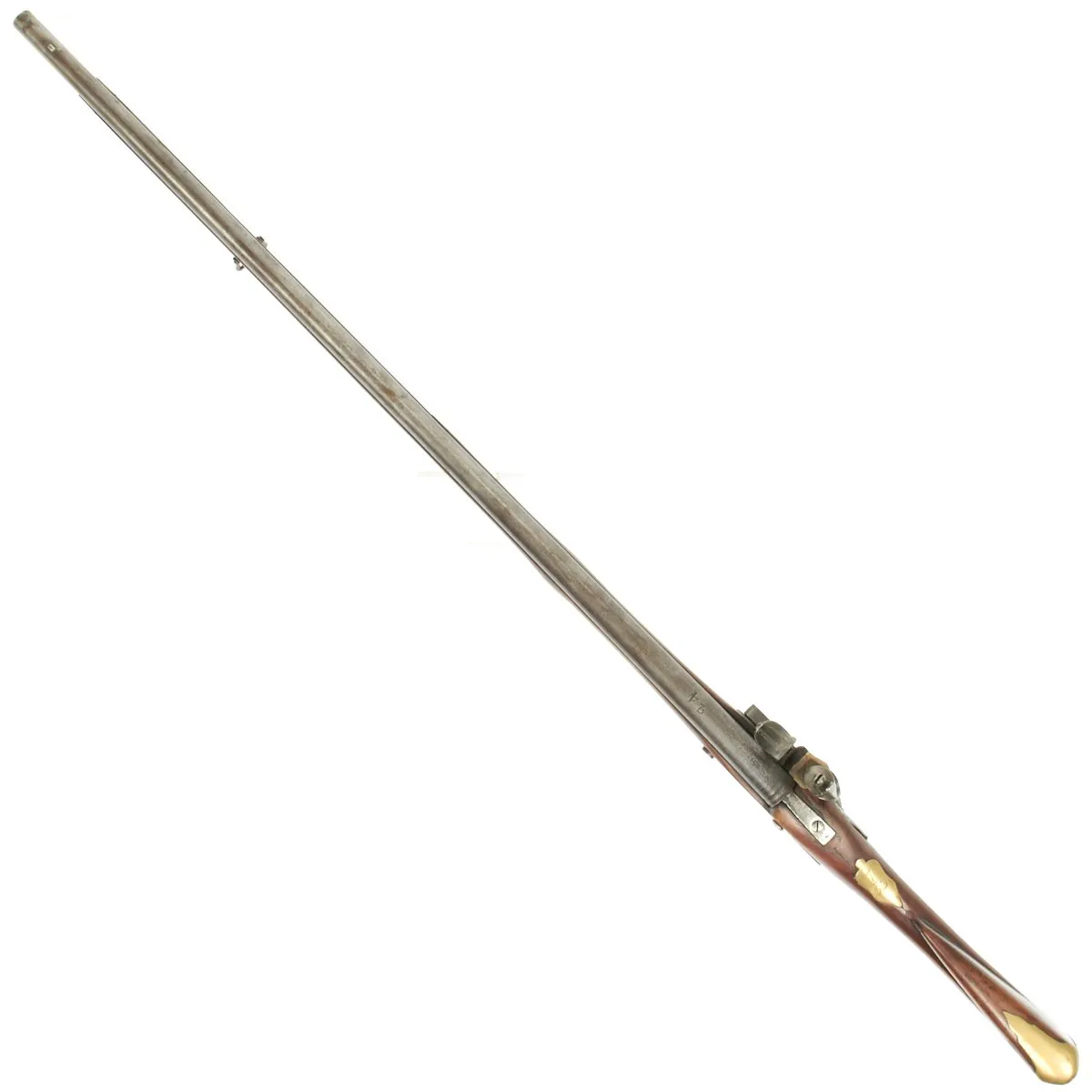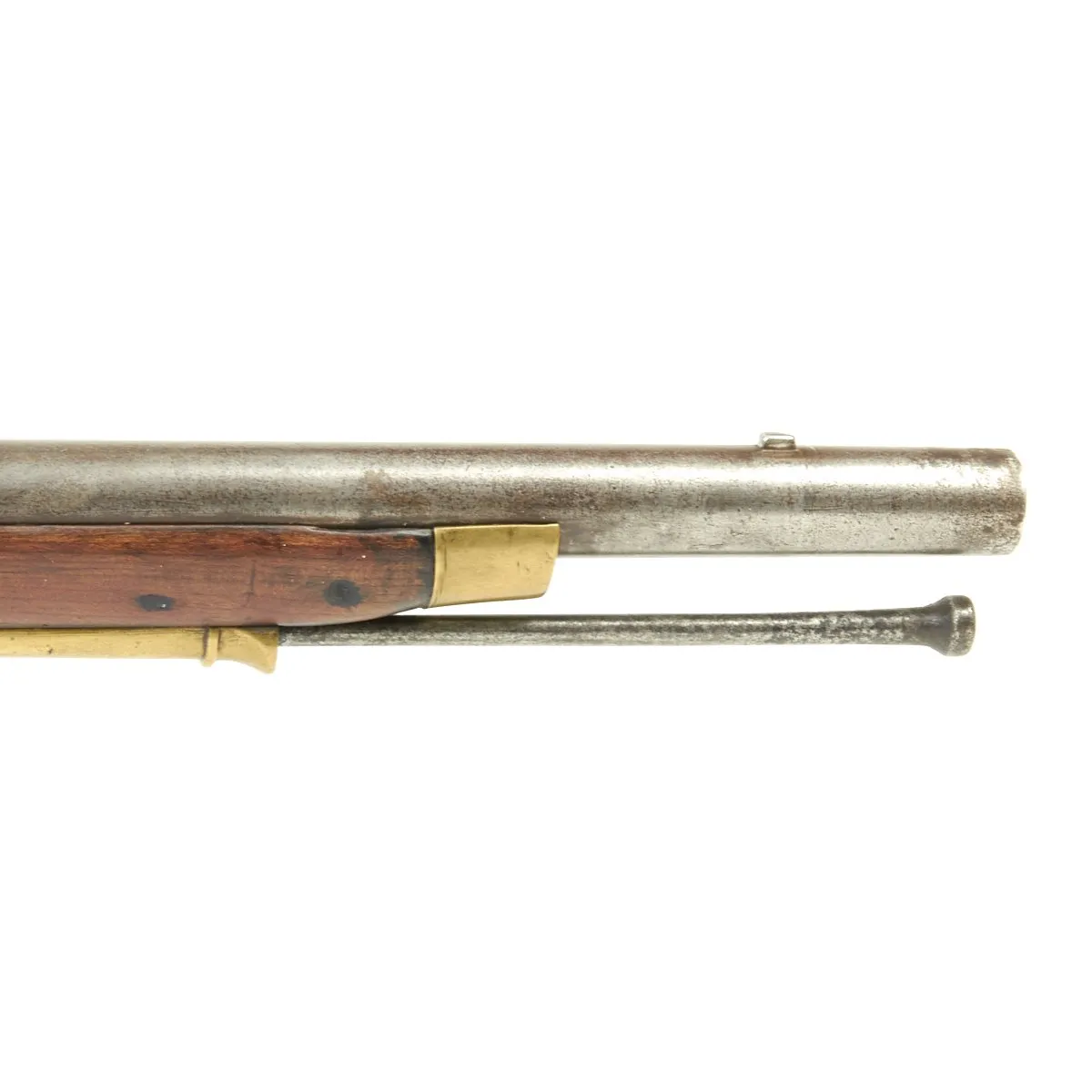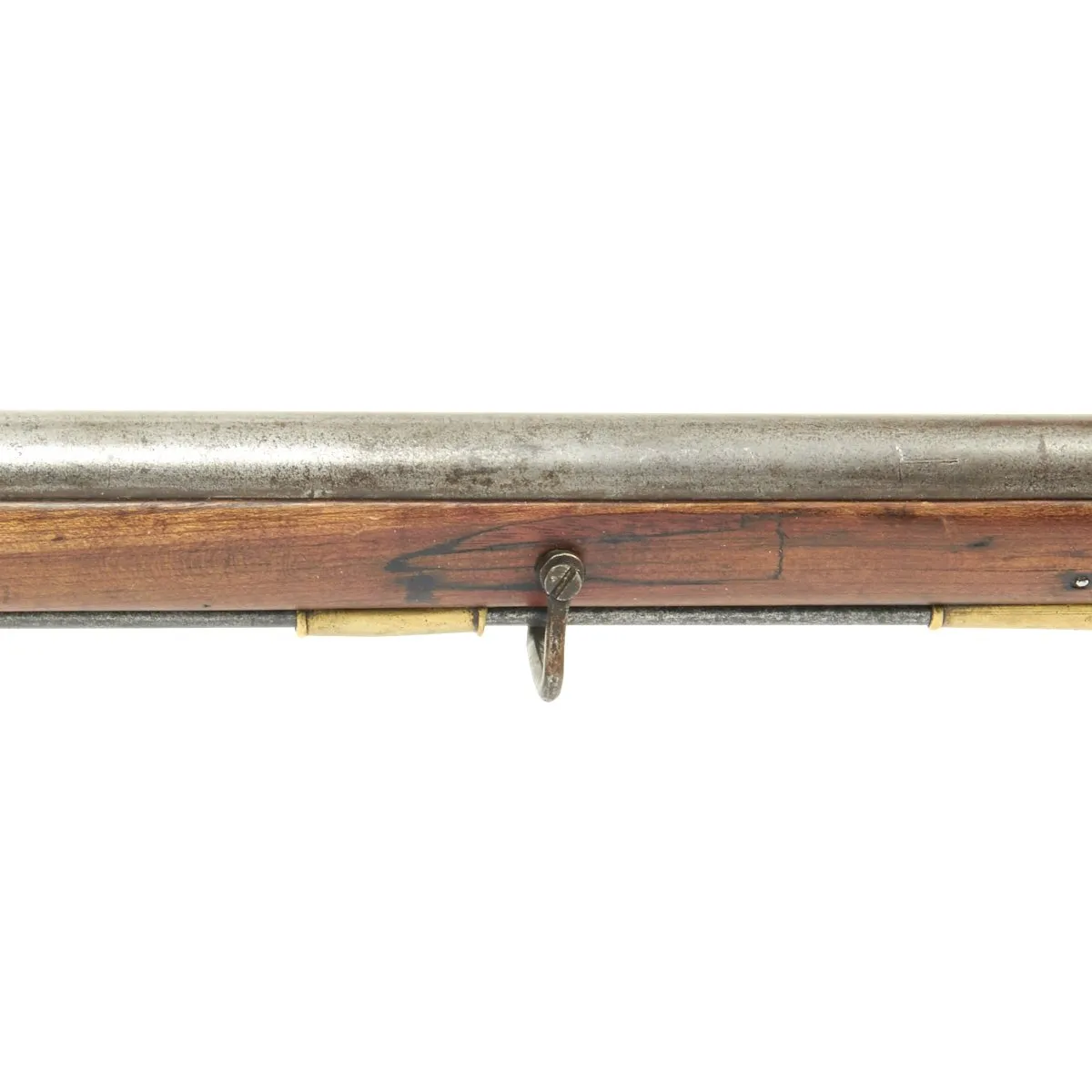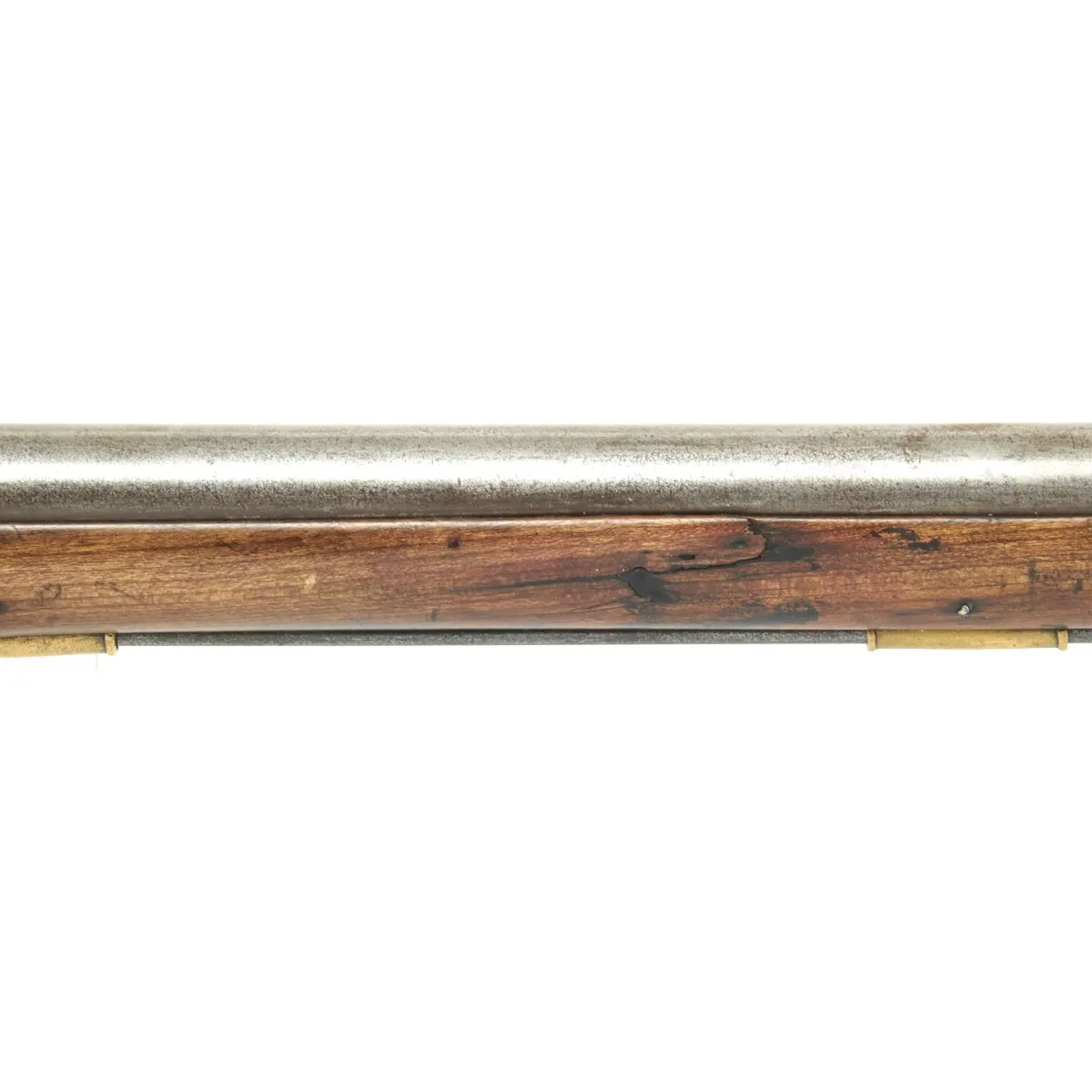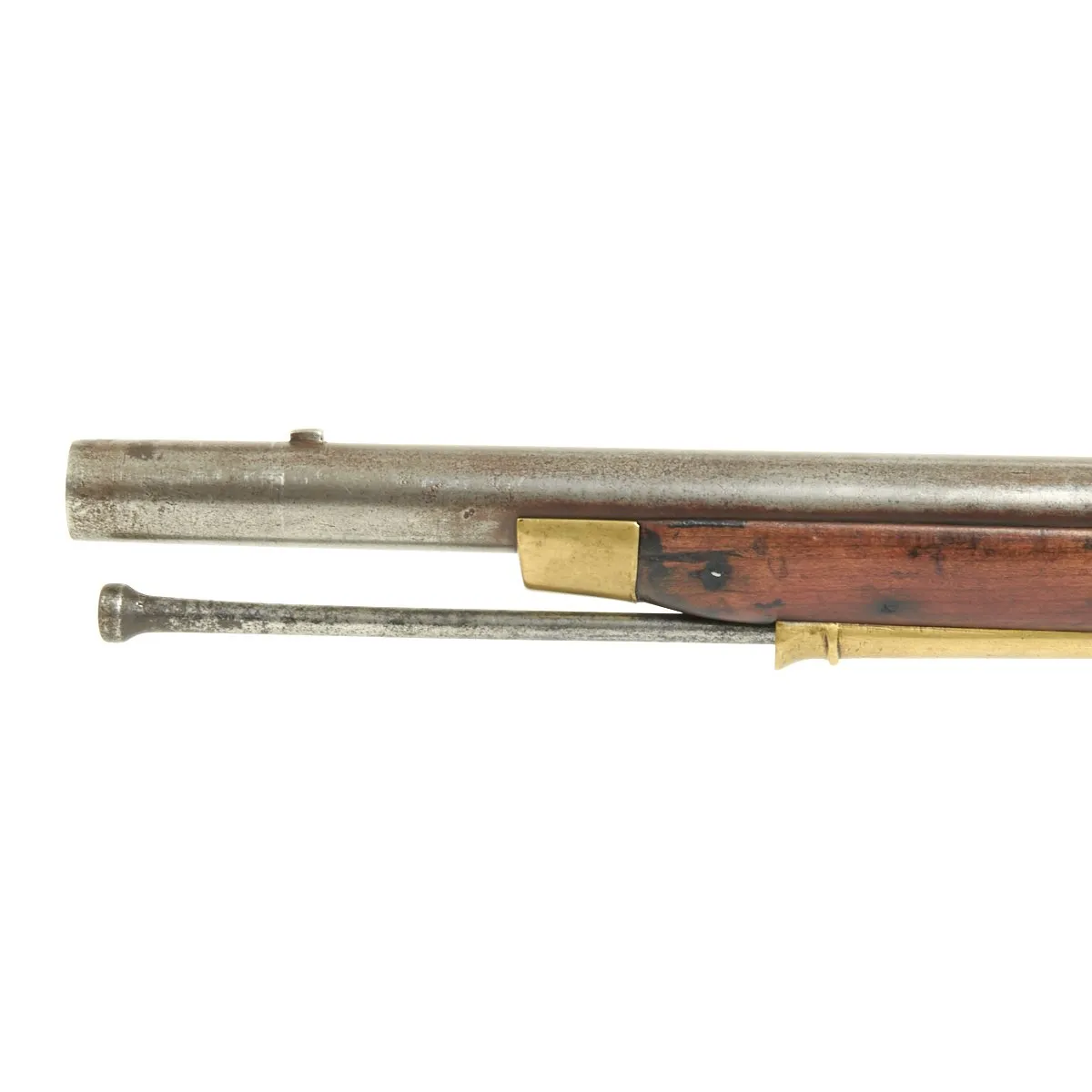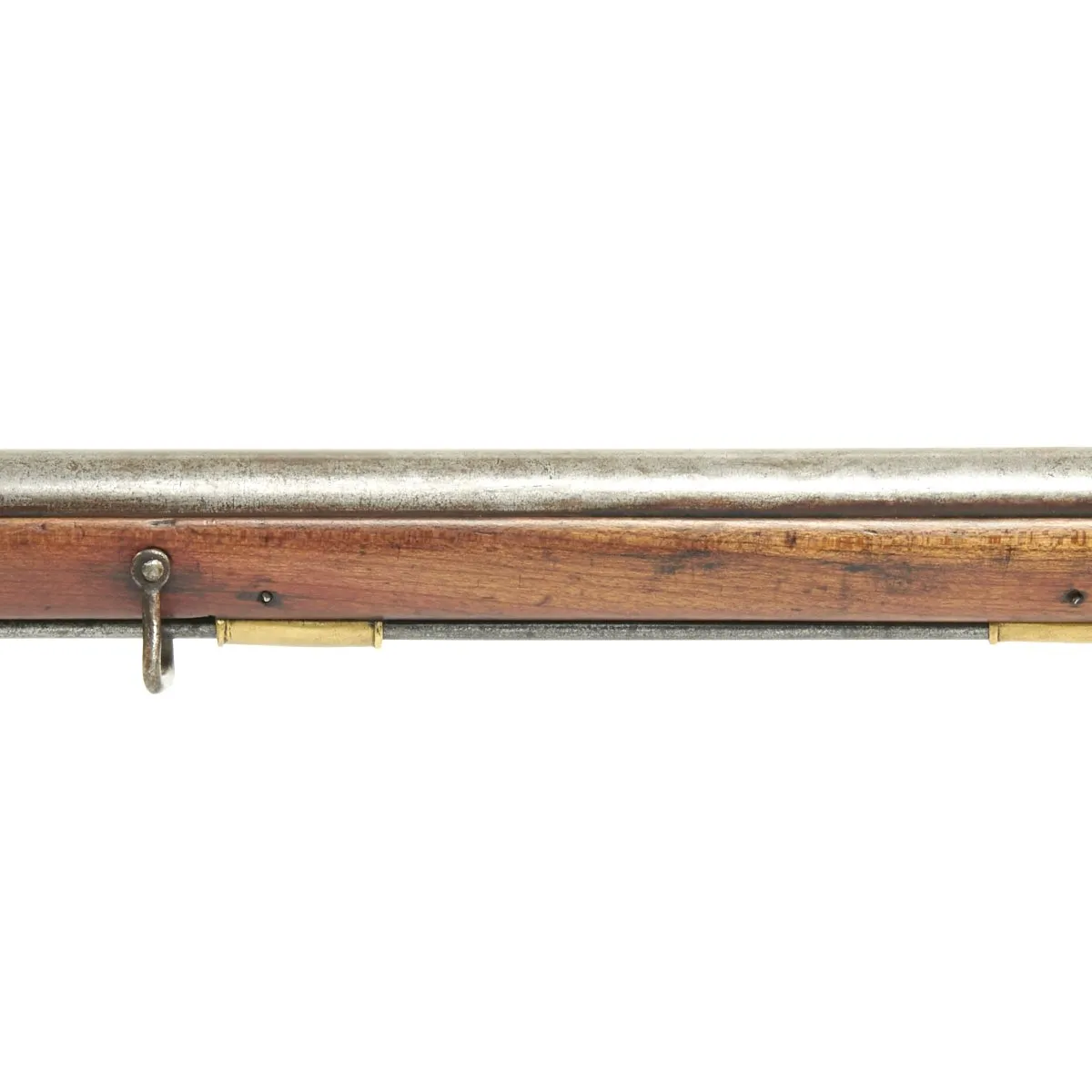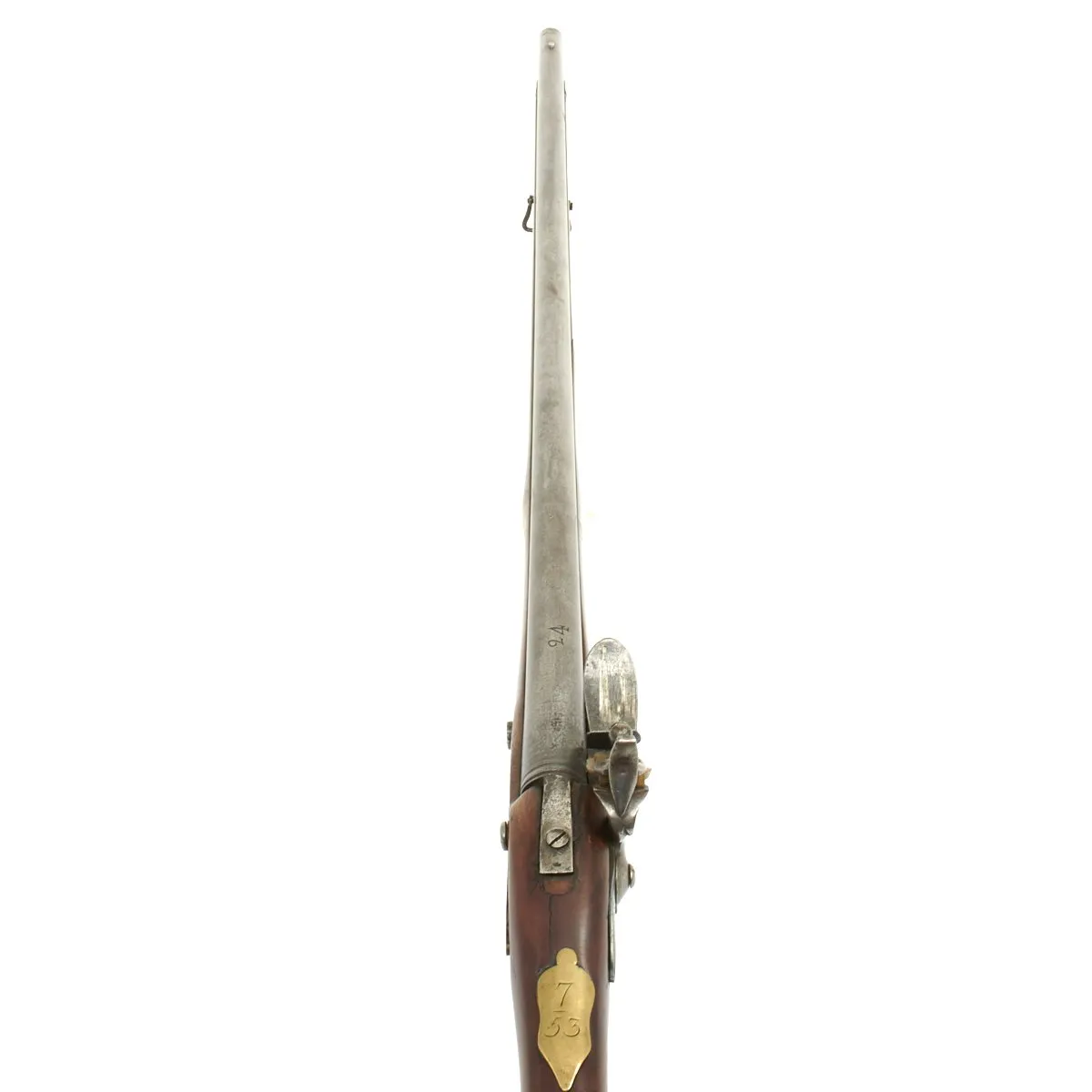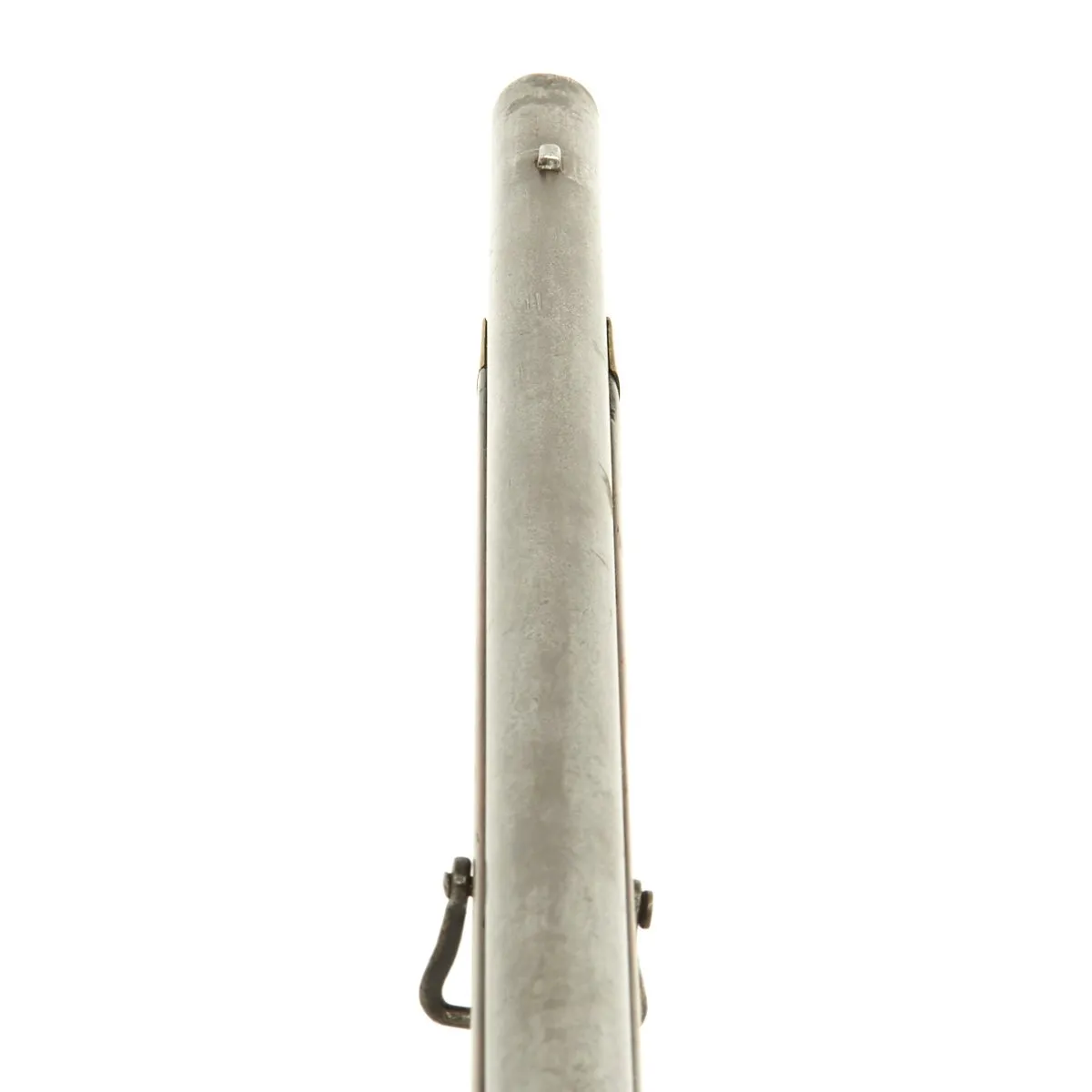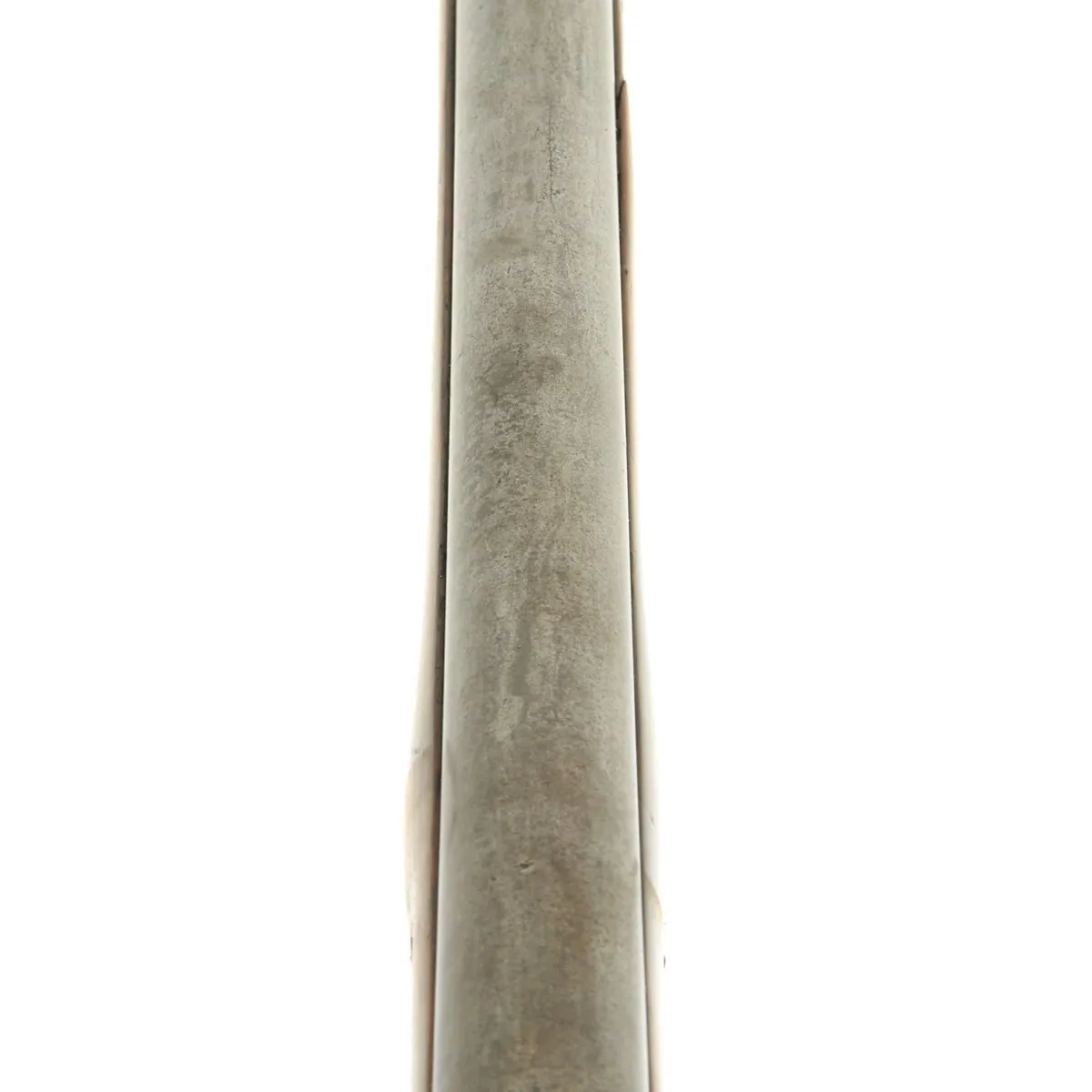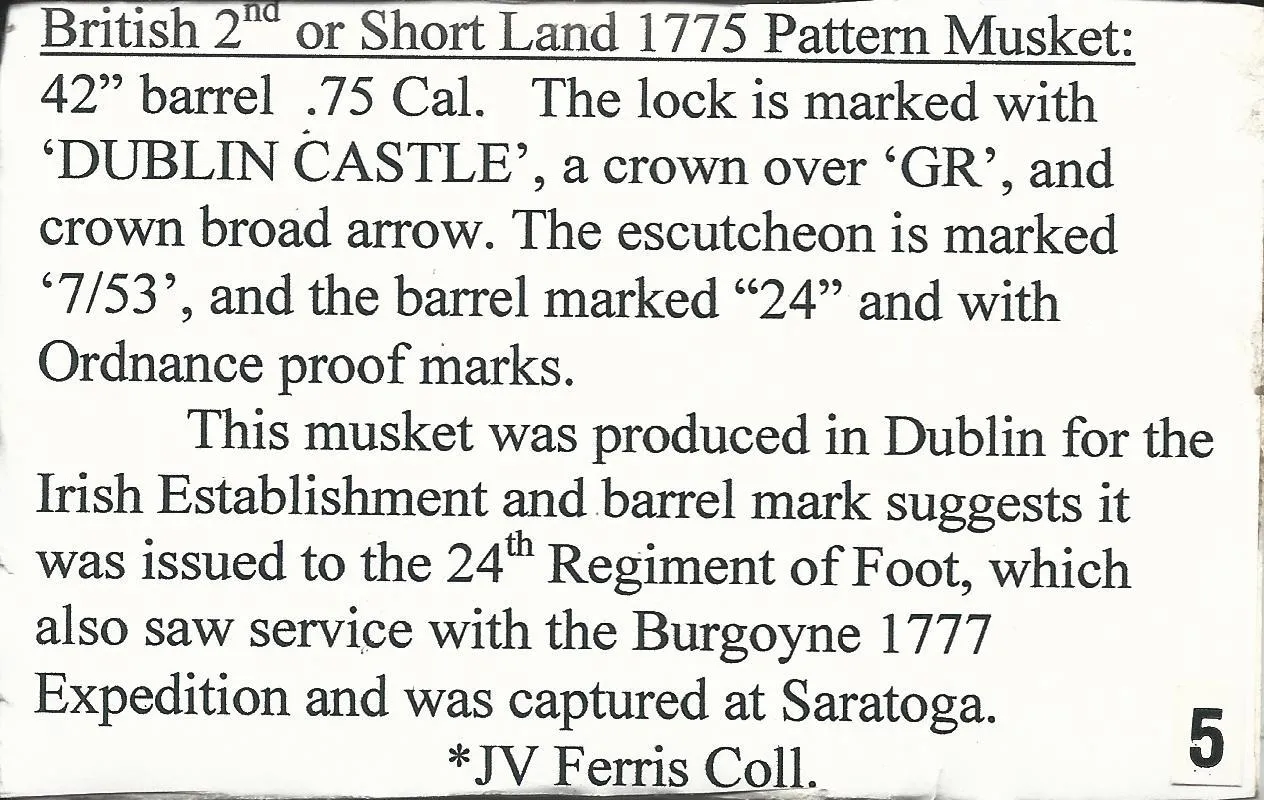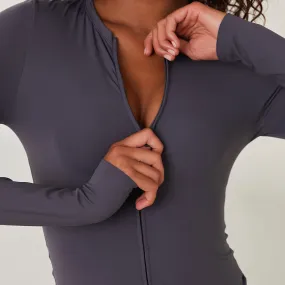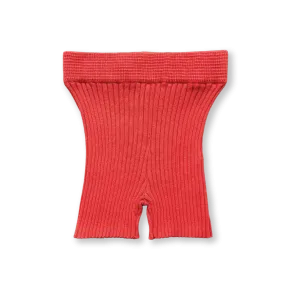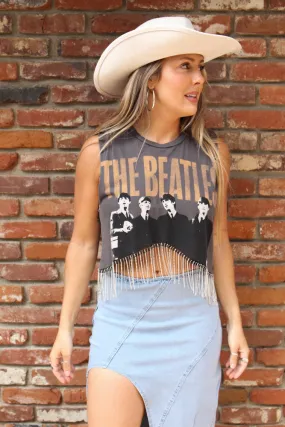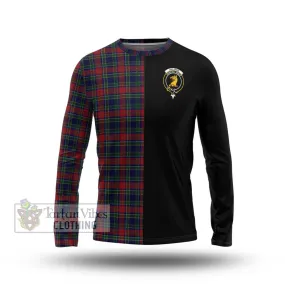Original Item: One-of-a-kind. IMA has acquired a collection of authentic American Revolutionary War weapons which, for the past 20 years, have been on display at the Princeton Battlefield State Park Clarke House Museum located in Princeton, New Jersey. This musket was part of that renowned collection.
The Short Land pattern musket became the official shoulder arm of the British army in 1768. Although large numbers of the Long Land weapons were in the hands of the British troops at the outset of the war, the shorter muskets were in service as well. Until the Spring of 1777 the Short Land muskets were equipped with locks with distinct features. These included a single screw showing behind the cock, a tre-foil end to the frizzen spring, and the older Long Land style cock.
This weapon is a British Short Land pattern musket. The lock has the standard British markings beneath the flashpan and the words DUBLIN CASTLE on the tail of the lockplate. Dublin Castle was an armory in Ireland that supplied weapons to the Ordnance from about 1760. It has the features of the locks found on Short Land muskets made prior to 1777. The 42 inch .75 caliber barrel has the standard Ordnance proof marks on the breech as well as a large and deeply stamped number 24 midway on the barrel. The escutcheon plate of this weapon is marked 7/53 which suggests that the musket was issued to the 7th troop and was the 53rd man's weapon in the 24th Regiment of Foot It could also mean 53rd Regiment of Foot. However, the very unusual barrel mark of 24 almost certainly refer to a regimental number. Regardless, both the 53rd Regiment and the 24th Regiment of Foot saw action in America during the Burgoyne Expedition.
This early Short Land pattern musket is in overall excellent condition. Its' markings are unusually clear and crisp for this type firearm. A photograph of the mark on this musket appeared in the May 1994 issue of The Gun Report, in an article entitled, "Colonial Firearms Displayed at the Princeton Battlefield". This weapon was on display at the Fort Ticonderoga Museum in 1992, and is currently on display at the Thomas Clarke House, in the Princeton Battlefield State Park, in a special exhibit called, "Arms of the Revolution".
This amazing musket is correct in every respect and shows use commensurate with its age and military service. Offered in wonderful condition having been on public display in the Sate of New Jersey Revolutionary War Museum for over 20 years.
The Saratoga Campaign in 1777 was an attempt by the British high command for North America to gain military control of the strategically important Hudson River valley during the American Revolutionary War. It ended in the surrender of the British army, which historian Edmund Morgan argues, "was a great turning point of the war, because it won for Americans the foreign assistance which was the last element needed for victory."[7]
The primary thrust of the campaign was planned and initiated by General John Burgoyne. Commanding a main force of some 8,000 men, he moved south in June from Quebec, boated up Lake Champlain to middle New York, then marched over the divide and down the Hudson Valley to Saratoga. He initially skirmished there with the Patriot defenders with mixed results. Then, after losses in the Battles of Saratoga in September and October, his deteriorating position and ever increasing size of the American army forced him to surrender his forces to the American General Horatio Gates on October 17.
In this critical British loss in the field of battle, all of the related elaborate strategies that had been drawn up in far away London proved to have failed. Colonel Barry St. Leger had been assigned to move east through the Mohawk River valley on Albany, New York, but was forced to retreat during the Siege of Fort Stanwix after losing his Indian allies. The major expedition from the south never materialized due to miscommunication with London when General William Howe sent his army to take Philadelphia rather than sending it up the Hudson River to coordinate with Burgoyne. A last-minute effort to reinforce Burgoyne from New York City was made in early October, but it was too little, too late.
The American victory was an enormous morale boost to the fledgling nation. More importantly, it convinced France to enter the war in alliance with the United States, openly providing money, soldiers, and munitions, as well as fighting a naval war worldwide against Britain.
Specifications:
Year of Manufacture: Circa 1768-177Caliber: .75" Musket
Ammunition Type: Lead Ball & Powder
Overall Length: 58 inches
Barrel Length: 42 inches
Action: Flintlock
Feed System: Muzzle-Loaded
NOTE: International orders of antique firearms MUST be shipped using UPS WW Services (courier). USPS Priority Mail international will not accept these.
Footnotes:
1) Darling, Red Coat and Brown Bess, p. 39. Darling stated that the re-inforced collar on the 2nd ramrod guide is an invention of John Pratt, starting in 1777 ( it is however possible that this improvement was used on private contract arms at an earlier date ). This gun has a Pratt improvement. DeWitt Bailey, in his fine work British. Military Longarms 1715-1865, p. 31, states that by 1785 proofmarking was done on the left side of the barrel. The marks on the Clark musket are centered.
2) Flayderman, Flayderman's Guide to Antique American Firearms, 3rd Edition, p. 588.
3) In 1794 the British Ordnance Department sanctioned the use of muskets which in modern times has become known as the Third model or India pattern Brown Bess. Its' .75 caliber barrel had been reduced to 39 inches, only three ramrod pipes were provided, the escutcheon plate was discarded, and the simplified brass furniture of the East India pattern muskets was used. Whether any of these Third model muskets were used here during the American Revolution is questionable. However, some evidence does exist to show that while they were not accepted as the British shoulder arm until 1794, prototype Third model weapons might have been used here during the war. Recent evidence from excavated Revolutionary War battle sites tends to show that some India pattern guns were used here ( Flayderman, Flayderman's Guide to Antique American Firearms, 3rd Edition, p. 588. ). Noted historian and collector Dale Anderson states that the Smithsonian Institute is now certain that Third models appeared about 1777 and that the National Park Service has a complete Third model confiscated from the British at Yorktown (Anderson, Antique Arms Catalog # 83, p. 1 ). There is also some evidence to show that captured Third models might have been stored in Federal armories after the war ( Guthman, U.S. Army Weapons 1784-91, p. 15 ). It is known that simplified India pattern type triggerguards were used on privately made British firearms before and during the Revolution. George Neuman, in his fine work "History of Weapons of the American Revolution ", p. 63, items M-14 and M-15, illustrates two such firearms which he dates as circa 1750.
4) Blackmore, British Military Firearms 1650-1850, p. 62. 5Neal and Back, British Gunmakers Their Trade Cards, Cases, and Equipment 1760-1860, p. 36. 6In his Antique Arms Catalog #88, item 925, Mr. Flayderman offered for sale a musket with a "CROWN/ GR" on the lock and a "N.Y." mark on the buttplate. In his Catalog #92, item 822 and Catalog #96, item 1068 he offered for sale muskets with "N.Y." marks on the buttplates and "CLARK" engraved on the locks.
7) The musket marked "N.Y. 25" was previously in the John Ferris Collection and is now in the IMA collection. The musket marked "N.Y. 31" was offered for sale at the Baltimore Gun Show in the Spring of 1988.
8) New York State Publications, The American Revolution in New York, p. 211.
9) Ibid., p. 218.
10) Darling, Red Coat and Brown Bess, p. 23.
11) Lancaster, The American Heritage History of the American Revolution, p. 322.
12) Mollo and MacGregor, Uniforms of the American Revolution, p. 38. Regarding the arms of the Provincials in the Spring of 1778, the authors state," The weapons were the same as the regulars, although in many cases the Provincials received the older Long Land model of Brown Bess." Apparently both First and Second model muskets made up the armament of the Torries. Also, reference to the Provincials being issued Second model guns is made in the New York State Historical Society Publications, Orderly Book of the Three Battalions of Loyalists Raised by Delancey, p. 77.
13) Moller, American Military Shoulder Arms, Volume 2, p. 194.

